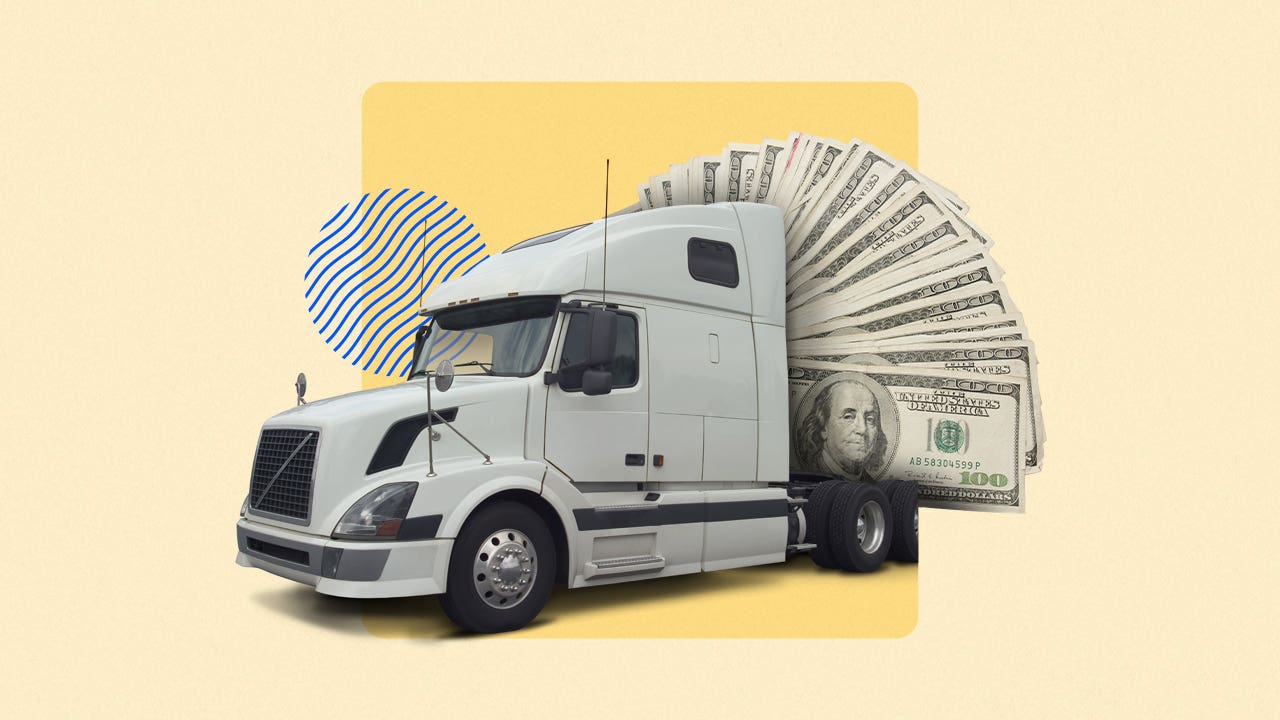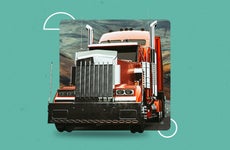How to get semi-truck financing

The Bankrate promise
At Bankrate we strive to help you make smarter financial decisions. While we adhere to strict , this post may contain references to products from our partners. Here's an explanation for .
Key Takeaways
- Semi-truck financing is an option for business owners who want to borrow money to buy a truck.
- Your credit score will play a significant role in your ability to qualify for a loan.
- Banks, credit unions, online lenders and direct lenders all offer semi-truck loans
A new semi truck can cost up to $200,000 with all the bells and whistles, and financing is often an affordable option for small business owners who can’t afford to pay cash. Even if you could pay out of pocket, using a loan frees up cash that can be used to help keep your business running. On the downside, the upfront costs of financing a truck are higher than those for leasing, so you should make sure you’re not stretching your financial limits by taking out a loan. Follow these tips to get the best semi-truck loan for your business.
1. Check your credit
Before you apply for a semi-truck loan, you should check your credit score. Most lenders check your personal credit score especially if you’re a startup with just a few years in business. They may also check your business credit score if you’ve built up your business credit by using credit such as credit cards or vendor payments.
Both scores show your history of paying back debt as well as how much debt you currently carry. Lenders use these scores to determine how risky it is to loan you money. A higher score often translates into faster approval and better terms, including a potentially lower interest rate.
Factors that impact a credit score include:
- Current outstanding debt
- Bill payment history
- Number of credit accounts open
- Types of credit you use
- How long your accounts have been open
- Percentage of available credit being used
- Past bankruptcies, foreclosures or collections attempts
While you may get a business loan with bad credit, it’s easier to get approved if you have a credit score in the good or excellent range. Different credit bureaus score your credit differently. As a general rule, a FICO credit score of at least 670 is considered good.
Business credit score models vary, but some, like your Paydex score, have a range from 1 to 100. A Paydex score of 80 to 100 suggests that you’re a strong candidate for a business loan. If you’re not sure what your current credit rating looks like, look at your business credit reports.
2. Determine the type of semi-truck financing
There are a few different types of business loans that you can use to finance a semi truck. Here are three of the most common:
Business loans
A business loan gives you a lump sum payment that can be used for nearly any business expense, including buying a semi truck. If you need your financing to cover your entire startup costs, a loan may be the right answer. Traditional banks and credit unions typically require good credit and business history to approve a loan, such as a personal credit score above 670. Depending on the terms of the loan, you may need to use the truck as collateral like you would with an auto loan. You may also be asked to provide a down payment.
If you don’t have great personal or business credit, keep in mind that online or alternative lenders tend to be better options. Even so, you’re more likely to be required to offer a larger down payment if you have subprime credit, so have some cash ready for this purpose.
Equipment loans
Equipment loans are term loans that must be used for specific business equipment, such as semi trucks. This type of business loan is often more accessible than traditional bank loans. Credit scores, minimum annual revenue and time in business may all have relaxed requirements. That said, your truck will be used as collateral to secure the loan, and the bank will repossess it if you fall behind in payments. Equipment loans are also more likely to require a down payment than a traditional bank loan.
Equipment leasing
Equipment leasing for semi trucks involves renting equipment rather than purchasing it. Leasing is another solution for companies needing a semi truck, but it has pros and cons. On the one hand, leasing has a lower monthly cost than financing a purchase. Replacing the truck with a new one is easier if you have a lease.
On the other hand, you’ll never build equity in the vehicle or pay it off. That means you’ll be stuck with monthly payments for as long as you need the truck. Paying for a truck you don’t own means a higher long-term cost for leases than purchases.
Line of credit
You could use a business line of credit to purchase your semi truck or at least to fund the down payment. A line of credit is usually revolving like a business credit card, which means that you can reuse the credit line as needed as long as you have the line open. You also don’t have to use all of your available credit on your truck. You can use the remainder for other costs, like truck repairs down the line.
SBA loans
The US Small Business Administration guarantees SBA loans, helping to offset the risks of lenders approving your business. They’re a good option for businesses that have exhausted other financing options. SBA loans have interest rate caps, so lenders cannot charge more than a predetermined amount. SBA loans can be issued up to $5 million per loan, depending on factors like a business’s revenue and credit score.
There are several types of SBA loans, but the most common is the 7(a) loan. This loan is considered a general-purpose loan and can be used to fund day-to-day expenses or purchase equipment or materials, like a semi truck.
3. Find a semi-truck lender
When it’s time to shop around for a semi-truck lender you’ll likely have multiple lenders to choose from. When choosing, think about your priorities. Do you want the cheapest loan or the fastest funding?
Online banks or credit unions can offer low-cost loans, while alternative lenders may provide faster funding. Alternatively, direct lenders that sell vehicles and offer financing have valuable expertise that can help you find the right vehicle. Here are three of the best types of lenders for semi-truck financing:
Banks and credit unions
Some major banks like Wells Fargo and U.S. Bank offer commercial vehicle lending along with small business loans. Large banks may have strict requirements compared to alternative lenders, but they often offer lower interest rates. You could be a good candidate if you have solid credit and an established business. You may also have a leg up on approvals if you hold other accounts with the bank.
Alternative lenders
Online alternative lenders operate like regular banks, except they offer faster funding and more flexible terms. Alternative lenders often accept applications from people with poor credit scores in the 500s. They may also offer loan products not normally found with a traditional bank, including crowdfunding and peer-to-peer lending.
Direct lenders
Direct commercial truck lenders are non-bank lenders that specialize in truck loans. They work well for business owners who need non-traditional financing. For example, people with bad credit, past delinquencies or even bankruptcies could find the financing they need.
4. Get prequalified
Getting prequalified for semi-truck financing means a lender has assessed your business history and credit score and determined that you’re likely to qualify. They may run a soft credit check to gauge your creditworthiness, but it doesn’t affect your credit score. While getting prequalified doesn’t mean you’re officially approved, it means you’ve met a lender’s initial criteria and understand how much you might qualify for.
5. Find the type of semi truck you want to finance
You may be able to expedite your loan if you can tell the lender which vehicle you want to purchase and the price. Similar to buying a car, having more information about the vehicle rounds out your loan application. Some lenders may require detailed information about the semi truck, including the make, model, year, condition report and past repairs. It also helps to have photos.
Narrow down the type of truck for you by looking at several factors:
1. Compare new and used. New semi trucks are more expensive but may have a longer warranty and require fewer repairs. Used trucks can have lower monthly payments but may come with a shorter warranty window.
2. Narrow down amenities. Long-haul drivers will need a sleeper cab, while short-distance drivers can get by with a day cab. Consider your preferred fuel economy, type of truck and other features that make your job easier.
3. Select a transmission. Semi trucks are available with both automatic and manual transmissions. Think about which trucks will be more efficient for the type of driving and length of the trips you’re taking.
4. Always run a history check. For used trucks, check out the vehicle’s history report for details such as the title, accident and maintenance records.
5. Be realistic with your budget. Leave room in your business budget for future semi-truck repairs and upgrades by not financing more than you can afford upfront.
6. Get the right insurance
Your lender may not release funding for your loan until they know you have the right insurance for your truck. Truck owners will need to meet their state’s minimum insurance coverage, as well as additional coverage for the truck, trailer and cargo. You may also want worker’s compensation insurance if you have employees. Here’s a look at the common types of semi-truck insurance you’ll come across:
- Primary liability coverage. This covers damage to property or people caused by your truck while it is on the road.
- Physical damage insurance. This insurance can cover some physical damage to your truck in the event of an accident or theft.
- Bobtail insurance. This liability coverage covers damages to other vehicles and injuries to other people that occur when you drive your semi truck without a trailer.
- Non-trucking liability coverage. This protects you from liability claims that could occur when you use your semi truck for non-business.
- Cargo liability insurance. This insurance coverage helps you replace cargo that is damaged or lost during an incident such as an accident, storm or theft.
7. Apply for semi-truck financing
When you’re ready to apply for a new loan, you’ll need to verify that you meet the lender’s requirements. Then, gather the documents the lender requires to complete the application. Prepare to be asked questions about you, your business and the truck you’re financing.
Documents to have on hand when you apply for financing include:
- Business registration
- Current business balance sheets
- Current business income statements
- Up to three years of personal and business tax returns
- Up to one year of bank statements
- Commercial driver’s license (CDL)
- Proof of truck insurance
Bottom line
The best semi-truck financing grants access to funds that you can use to start or grow a trucking business. But before you apply for a business loan, you can do your research on truck costs, the type of truck you need and the payments you can handle. That way, you can come to the lender armed with information to expedite the approval process.
Frequently asked questions
-
Traditional banks and credit unions tend to favor terms of 12 to 60 months. But it’s possible to find loans that are seven years or longer, especially with online lenders and direct commercial truck lenders. The downside to such long loan terms is that you’ll be making interest payments longer. You may end up owing more than the semi truck is worth.
-
Financing a semi truck without a down payment requires excellent credit and sizeable annual revenue. Most lenders prefer and may require a down payment of at least 10 percent — higher if your credit is low.
-
Financing a truck means you have an asset for your company. Meanwhile, leasing can lower your monthly costs. Buying your truck is often the better long-term investment if you can afford it. But leasing is a good option if you struggle to secure financing or don’t want to be locked into a long-term loan.
Related Articles



